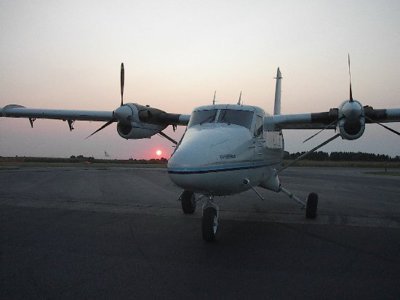Recommended Posts
rgoetsch 0
Edited by slotperfect to make the link clicky.
We gave one of these kits to an RC enthusiast at Jumptown (Orange, MA). He has it built and engines on- it almost ready for its first flight. He did really nice work and actually measured the floater bar and jump step to make sure he made them to scale. He did have to add struts- the kit did not have them.
cvfd1399 0
Unstable 8
Quote>>They turn the other direction in the southern hemisphere
>Naah, just russia...
Interesting point about some russian prop transports -
On most US aircraft, both props spin in the same direction. That means that there is something called a "critical engine." Without getting into too much detail, on multiengine planes with engines spinning the same direction there is one engine that, if you lose power on it, the plane becomes harder to control than if you lose power on the other engine. Some russian transports are designed with props that spin opposite directions on opposite sides of the plane, such that there is no critical engine.
They make them in the USA too. The Cessna 303 Crusader (my first multi-engine plane) had counter-rotating props.
http://www.acf.clara.net/scale/scale-pics-3/low-wing/cessna-303-crusader/c.jpg
www.diverdriver.com
ATP/D-19012
FB #4125
FrogNog 1
QuoteWhat is the max air speed in a dive(140knots)?
Like in free fall is there anything you can do to cause drag in a dive other than having speed braked installed(can you do that on a otter) turn the blades full sideways, flaps?
One of the best ways to increase drag is to go faster. Drag increases at the cube of the increase in speed. So going twice as fast (in a viscious liquid like air) makes the drag eight times as much. So just pointing the airplane at the ground and letting it fly at a higher airspeed helps. Increased airspeed has other effects, though, which is why 1. there are maximum airspeeds for various aircraft and 2. some aircraft use speed brakes / dive brakes to help out.
Since airplane engines are generally air-cooled (a design characteristic I applaud as a sensible use of plentiful resources), increased airspeed leads to increased cooling. Piston engines can be damaged if they get hot from working hard (e.g. pulling fat jumpers with oversized canopies to altitude
That's where airbrakes come in. They help. But it is my understanding that turbine-engine planes generally don't need that help anywhere near as much as piston-engine planes.
-=-=-=-=-
Pull.
RTModels 0
Quotehttp://www.rtmodels.com/products/TwnOtter.htm
Edited by slotperfect to make the link clicky.
We gave one of these kits to an RC enthusiast at Jumptown (Orange, MA). He has it built and engines on- it almost ready for its first flight. He did really nice work and actually measured the floater bar and jump step to make sure he made them to scale. He did have to add struts- the kit did not have them.
I would love to see any pictures of the finished bird. While not a scale one not too many TO's in kit form for the RC'er We have one in developmnt in the 100" span which will be a FG and foam kit sometime in 06....so many designs and so little time
Thanks,
Mark
RTModels.com
QuoteDrag increases at the cube of the increase in speed.
Square, not cube.
Going faster is a pretty creative way of creating drag to keep airspeed lower... doesn't work very well!
Dave
QuoteQuoteQuoteDon't know if it's just me, or maybe others have thought about it
When your sitting next to the prop an watching it out of the window
how many of you have thought about what would happen if it came unglued
Have you also noticed the reinforced fuselage on the exterior of most (all?) Otters for this specific reason?
_Am
Andy, that's not for catching blades shedding themselves. That's for when you are flying in icing condistions and the ice breaks off and hits the fuselage. If those blades sling you aren't stopping them.
Yea, I thought about that before!
This was not an airplane but.........I used to work at a facility with a 3500 ton cooling tower and it had about 6 big fans. One day a main bearing went out on one of the fans and fan blades 8ft long went flying everywhere! Through the housing, grate and through the air 2 streets over.........no one hurt and it was kinda funny!
"Some call it heavenly in it's brilliance,
others mean and rueful of the western dream"





Share this post
Link to post
Share on other sites